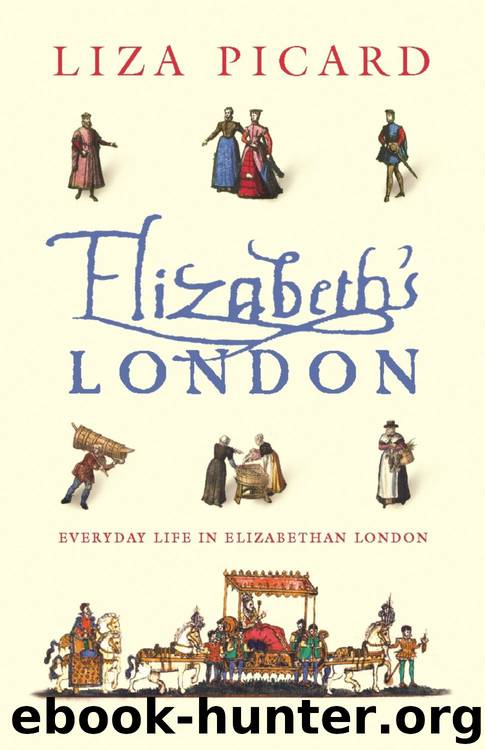Elizabeth's London by Liza Picard

Author:Liza Picard
Language: eng
Format: epub
Publisher: St. Martin's Press
Published: 2016-03-09T16:00:00+00:00
Marriage
Marriage involved a change of status. The woman moved from the power and responsibilty of her father, to that of her husband. The only women who were not treated as chattels in this way were widows, who were allowed to dispose of their own fates if they could. It was desirable for this change of status to be signalled in public, so that everyone should know that the new woman who had moved in round the corner was a respectable married lady, and so that her creditors knew they could press her husband to pay her debts.
This is a legalistic way of looking at marriage. The more normal way is to treat a wedding as an occasion for celebration. But before we get down to the cakes and ale, what was a valid marriage? As far as the Church was concerned, the only proper way was to have it publicised by the reading of banns, solemnised in church, before a congregation, by a parson, who would record it in a register and pocket his fee. The essence of the ceremony was the publicity given to it. The parties had to undertake that they knew of no reason, such as a previous marriage, or even a promise to marry someone else, why the ceremony should not proceed. Opportunities were also given to anyone else who had doubts about the capacity of either party, to say so, weeks before the service and again during it, before the parties exchanged their binding vows. This could be useful to a reluctant bridegroom. It was not unknown for a man to ‘remember’ a previous promise, even at the altar. The contract came into being when each party replied ‘I do’ to the question whether they took the other as their lawful wedded spouse. The parson’s pronouncement that they were then married merely recognised the fact.
Although the union was blessed by the Church, and referred to as ‘holy wedlock’, marriage was not a sacrament of the Anglican Church, as it had been of the pre-Reformation Catholic Church. The parson would issue a ‘testimony’ or certificate of the ceremony, which the bride kept carefully. It was part of the equipment of wandering vagabond couples, who when asked awkward questions as to whether they were respectably married and deserving of help could produce ‘a testimonial with the minister’s name … in a parish in some shire far away’.21 It was probably forged anyway.
But there were other routes. A special licence could be bought from the Church authority, to avoid all that publicity, but it cost more than most people would afford – nearly 10s in fees, and, after 1571, a substantial bond guaranteeing that there were no impediments to the marriage.22 A cheaper way was to dispense with the church service altogether. If each party took the other as his or her spouse, they were legally married, and if they chose slightly different words and said that they definitely would marry in the future, and followed that promise by sexual intercourse, they were equally bound.
Download
This site does not store any files on its server. We only index and link to content provided by other sites. Please contact the content providers to delete copyright contents if any and email us, we'll remove relevant links or contents immediately.
| General | Channel Islands |
| England | Northern Ireland |
| Scotland | Wales |
Room 212 by Kate Stewart(5040)
The Crown by Robert Lacey(4727)
Endurance: Shackleton's Incredible Voyage by Alfred Lansing(4683)
The Iron Duke by The Iron Duke(4293)
The Rape of Nanking by Iris Chang(4139)
Joan of Arc by Mary Gordon(4016)
Killing England by Bill O'Reilly(3953)
Say Nothing by Patrick Radden Keefe(3903)
I'll Give You the Sun by Jandy Nelson(3359)
Shadow of Night by Deborah Harkness(3306)
Hitler's Monsters by Eric Kurlander(3269)
Mary, Queen of Scots, and the Murder of Lord Darnley by Alison Weir(3152)
Blood and Sand by Alex Von Tunzelmann(3140)
Darkest Hour by Anthony McCarten(3072)
Eleanor & Park by Rainbow Rowell(3063)
Margaret Thatcher: The Autobiography by Thatcher Margaret(3029)
Red Famine: Stalin's War on Ukraine by Anne Applebaum(2874)
Book of Life by Deborah Harkness(2869)
The One Memory of Flora Banks by Emily Barr(2803)
